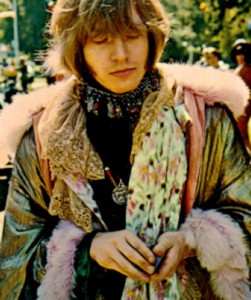 I reckon that Brian Jones was the dandiest heterosexual of the 20th century. And one of the randiest, too, having fathered at least five children with five different women by the time he was 23. But there was also real talent behind that foppish Casanova facade. Brian was one of Britain’s earliest practitioners of Delta blues. A natural musician, he was arguably the most versatile member of the band he formed and christened The Rollin Stones in 1962. And while he didn’t write, sing lead, or play solo on a single song during his career, his prowess as a multi-instrumentalist was unmatched in the rock world. He not only played a mean slide guitar, he was also proficient with harmonica, keyboards, recorder, clarinet, oboe, flute, saxophone, trumpet, trombone, sitar, tamboura, dulcimer, koto, harp, autoharp, mellotron, marimba, xylophone, glockenspiel, clavinet, banjo, accordion, harpsichord and many forms of percussion. The signature sounds you hear in “Paint it Black,” “Under My Thumb,” “Ruby Tuesday,” and “Little Red Rooster” are the work of Brian.
I reckon that Brian Jones was the dandiest heterosexual of the 20th century. And one of the randiest, too, having fathered at least five children with five different women by the time he was 23. But there was also real talent behind that foppish Casanova facade. Brian was one of Britain’s earliest practitioners of Delta blues. A natural musician, he was arguably the most versatile member of the band he formed and christened The Rollin Stones in 1962. And while he didn’t write, sing lead, or play solo on a single song during his career, his prowess as a multi-instrumentalist was unmatched in the rock world. He not only played a mean slide guitar, he was also proficient with harmonica, keyboards, recorder, clarinet, oboe, flute, saxophone, trumpet, trombone, sitar, tamboura, dulcimer, koto, harp, autoharp, mellotron, marimba, xylophone, glockenspiel, clavinet, banjo, accordion, harpsichord and many forms of percussion. The signature sounds you hear in “Paint it Black,” “Under My Thumb,” “Ruby Tuesday,” and “Little Red Rooster” are the work of Brian.
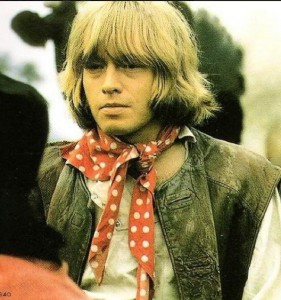 Today would have been his 73rd birthday had he not succumbed at age 27 to a drug-related drowning in his swimming pool on July 3, 1969, just weeks after his bandmates fired him for erratic, unprofessional behavior. The British coroner’s report deemed it “death by misadventure,” but many suspected foul play on the part of Frank Thorogood, a contractor who had been supervising the renovation of Brian’s Cotchford Farm estate. Thorogood, on his deathbed, supposedly confessed to murdering Jones in the pool. It’s still a mystery. Even conspiracy-mad medical examiner Cyril Wecht couldn’t confirm a bona fide murder after analyzing the autopsy report and remaining evidence.
Today would have been his 73rd birthday had he not succumbed at age 27 to a drug-related drowning in his swimming pool on July 3, 1969, just weeks after his bandmates fired him for erratic, unprofessional behavior. The British coroner’s report deemed it “death by misadventure,” but many suspected foul play on the part of Frank Thorogood, a contractor who had been supervising the renovation of Brian’s Cotchford Farm estate. Thorogood, on his deathbed, supposedly confessed to murdering Jones in the pool. It’s still a mystery. Even conspiracy-mad medical examiner Cyril Wecht couldn’t confirm a bona fide murder after analyzing the autopsy report and remaining evidence.
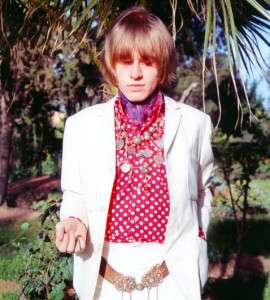 Keith Richards has long doubted the deathbed confession story, figuring that Brian, unlike himself, just couldn’t cut the chemical mustard. But he sardonically suggests that the fussy Brian might have driven someone to want to murder him. “…I can imagine the scenario of Brian being so obnoxious to Thorogood and the building crew he had working on Brian’s house that they were just pissing with him,” said Keith in his book, Life. “He pissed off the builders, whining son of a bitch.” Oh, Keith!
Keith Richards has long doubted the deathbed confession story, figuring that Brian, unlike himself, just couldn’t cut the chemical mustard. But he sardonically suggests that the fussy Brian might have driven someone to want to murder him. “…I can imagine the scenario of Brian being so obnoxious to Thorogood and the building crew he had working on Brian’s house that they were just pissing with him,” said Keith in his book, Life. “He pissed off the builders, whining son of a bitch.” Oh, Keith!
With the passing of Brian, the rock world not only lost one of its pioneering (albeit, undisciplined) blues-rock talents, the fashion world lost one its most daring and original style setters. Thanks to Stones bass player Bill Wyman, who took meticulous notes during his 31 years with the band, we have a record of Brian’s buying habits. In his book, Stone Alone, Wyman describes the nature of Brian’s shopgasms:
 “Our sharpest dresser, he spent a small fortune at boutiques. Collecting clothes might have been his kind of therapy, as he shopped more frequently during times of stress: the day after his court case was adjourned he went to Chelsea Antique Market for a spree typical in its list of exotic purchases: a mandarin coat, a pink fringed coat, pink velvet cape, a flannel-and-lace jacket, embroidered and velvet jackets, two velvet scarves, four pairs of trousers, two kimonos and two scarves, two strings of bells, a blouse and a pink beaded belt. In New York, too, Brian had indulged himself in expeditions to the ladies jewelry departments of such stores as Saks Fifth Avenue and Bergdorf Goodman. A New York journalist friend commented: ‘If he gave nothing else to the world, Brian was the first heterosexual male to start wearing costume jewelry from Saks Fifth Avenue.'”
“Our sharpest dresser, he spent a small fortune at boutiques. Collecting clothes might have been his kind of therapy, as he shopped more frequently during times of stress: the day after his court case was adjourned he went to Chelsea Antique Market for a spree typical in its list of exotic purchases: a mandarin coat, a pink fringed coat, pink velvet cape, a flannel-and-lace jacket, embroidered and velvet jackets, two velvet scarves, four pairs of trousers, two kimonos and two scarves, two strings of bells, a blouse and a pink beaded belt. In New York, too, Brian had indulged himself in expeditions to the ladies jewelry departments of such stores as Saks Fifth Avenue and Bergdorf Goodman. A New York journalist friend commented: ‘If he gave nothing else to the world, Brian was the first heterosexual male to start wearing costume jewelry from Saks Fifth Avenue.'”
 Well, he might have been a peacock, masking myriad neuroses with velvet and chintz, but Mr. Jones gave a lot more to the world than man-bracelets and puka shell necklaces. Although there are those among you who will disagree, there would have been no Rolling Stones without Brian Jones. Sure, Mick and Keith would have gone on to be huge rock stars; Charlie and Bill to be highly respected rhythm men. But Brian was the one with the vision for a pure blues band – back when Mick was still contemplating a career as a pin-striped businessman.
Well, he might have been a peacock, masking myriad neuroses with velvet and chintz, but Mr. Jones gave a lot more to the world than man-bracelets and puka shell necklaces. Although there are those among you who will disagree, there would have been no Rolling Stones without Brian Jones. Sure, Mick and Keith would have gone on to be huge rock stars; Charlie and Bill to be highly respected rhythm men. But Brian was the one with the vision for a pure blues band – back when Mick was still contemplating a career as a pin-striped businessman.
And while most of us Stone-heads consider the band’s post-Brian LPs to be among the best and most enduring rock albums ever made, there’s no denying the significance of his early contributions. As Wyman once said, “He formed the band. He chose the members. He named the band. He chose the music we played. He got us gigs…very influential, very important, and then slowly lost it — highly intelligent — and just kind of wasted it and blew it all away.”
Another once-beautiful dead flower. Rest in peace and paisley, Brian Jones!
Here is a montage of photos showing Brian Jones in all his glory. “Who could hang a name on you?”
© Dana Spiardi, Feb 28, 2014
]]>
From Carnaby Street to The King’s Road (once described as “a wilderness of stoned harlequins,” by antiques dealer Christopher Gibbs), swinging London was the center of the universe for hip ’60s culture. As The Kinks succinctly summed it up: “Everywhere the Carnabetian Army marches on, each one a dedicated follower of fashion.” Boutiques with names like Granny Takes a Trip and I Was Lord Kitchener’s Valet were the hot spots for U.K. rock royalty. The Beatles added to the scene when they opened The Apple Boutique, described by Paul McCartney as “a beautiful place where beautiful people can buy beautiful things.” Glad-rags galore! Given the enormous influence of English musicians and designers on popular culture, I hereby present my awards for 1960s British sartorial splendor.
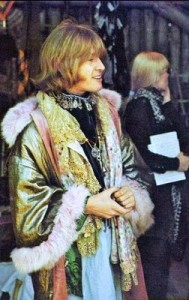 Gold Medal Winner: Brian Jones, founding member of the Rolling Stones, was a talented, versatile artist and the ultimate ’60s fashion plate. The tie-dyed American hippies didn’t know what hit them when Lord Brian descended from the heavens to attend the 1967 Monterey Pop festival. “Brian, in mind-shattering gold lamé coat festooned with beads, crystals and lace, was the unofficial king of the festival,” reported New Musical Express magazine. In his book Stone Alone, bandmate Bill Wyman lists the items purchased during a typical Brian Jones shopping spree: a mandarin coat, a pink fringed coat, pink velvet cape, a flannel-and-lace jacket, embroidered and velvet jackets, two velvet scarves, four pairs of trousers, two kimonos and two scarves, two strings of bells, a blouse and a pink beaded belt. Alas, the fragile Jones, a father of five, died in a swimming pool at age 27 a few weeks after his Stone-mates booted him from the band in 1969.
Gold Medal Winner: Brian Jones, founding member of the Rolling Stones, was a talented, versatile artist and the ultimate ’60s fashion plate. The tie-dyed American hippies didn’t know what hit them when Lord Brian descended from the heavens to attend the 1967 Monterey Pop festival. “Brian, in mind-shattering gold lamé coat festooned with beads, crystals and lace, was the unofficial king of the festival,” reported New Musical Express magazine. In his book Stone Alone, bandmate Bill Wyman lists the items purchased during a typical Brian Jones shopping spree: a mandarin coat, a pink fringed coat, pink velvet cape, a flannel-and-lace jacket, embroidered and velvet jackets, two velvet scarves, four pairs of trousers, two kimonos and two scarves, two strings of bells, a blouse and a pink beaded belt. Alas, the fragile Jones, a father of five, died in a swimming pool at age 27 a few weeks after his Stone-mates booted him from the band in 1969.
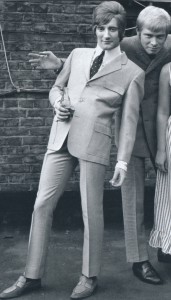 Silver Medal Winner: Rod Stewart has donned many a flashy fashion: leopard print suits, gauzy jumpsuits, tartan scarves and caps, and blood clot-inducing disco pants. But he was at his style peak in 1965, when he sang with Steampacket and Long John Baldry’s Hoochie Coochie Men. With his back-combed, perfectly coiffed hair, high-heeled boots, checked pants and leather back-belted coats, he was the darling of the London club scene. Even the generally staid BBC took notice, featuring the 20-year-old in a 1965 TV documentary titled “Rod the Mod.” Members of many bands – The Kinks, The Who, The Small Faces – styled themselves as Mods, but Rod topped them all. “I’ve always been very flashy.” Rod once said. “Even when I was at school I had to be the best dressed.” And for a few brief years in the mid-60s, he was just that. At age 67, he still dazzles audiences with his tousled locks and coats of many colors.
Silver Medal Winner: Rod Stewart has donned many a flashy fashion: leopard print suits, gauzy jumpsuits, tartan scarves and caps, and blood clot-inducing disco pants. But he was at his style peak in 1965, when he sang with Steampacket and Long John Baldry’s Hoochie Coochie Men. With his back-combed, perfectly coiffed hair, high-heeled boots, checked pants and leather back-belted coats, he was the darling of the London club scene. Even the generally staid BBC took notice, featuring the 20-year-old in a 1965 TV documentary titled “Rod the Mod.” Members of many bands – The Kinks, The Who, The Small Faces – styled themselves as Mods, but Rod topped them all. “I’ve always been very flashy.” Rod once said. “Even when I was at school I had to be the best dressed.” And for a few brief years in the mid-60s, he was just that. At age 67, he still dazzles audiences with his tousled locks and coats of many colors.
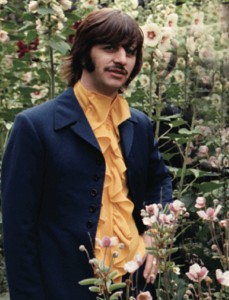 Bronze Medal Winner: Ringo Starr was a hep-cat long before he became a Beatle. As the drummer for Rory Storm and the Hurricanes, he stood out from other early British Elvis wanna-bes with his beatnik beard, string-ties and heavily ringed fingers. All the Beatles looked boss in their psychedelic, India-inspired styles (with Paul being the least adventurous), but Ringo always looked the most effortlessly sharp. He was hip without being flamboyant. He had an excellent sense of color and chose tasteful outfits that perfectly suited his 5’6″ frame. His clothing, like his drumming, was understated, yet striking. Just take a look at the “Abbey Road” album cover. Need I say more? He’s still fit and trim at age 72, and remains one of the classiest Brits in the rock business.
Bronze Medal Winner: Ringo Starr was a hep-cat long before he became a Beatle. As the drummer for Rory Storm and the Hurricanes, he stood out from other early British Elvis wanna-bes with his beatnik beard, string-ties and heavily ringed fingers. All the Beatles looked boss in their psychedelic, India-inspired styles (with Paul being the least adventurous), but Ringo always looked the most effortlessly sharp. He was hip without being flamboyant. He had an excellent sense of color and chose tasteful outfits that perfectly suited his 5’6″ frame. His clothing, like his drumming, was understated, yet striking. Just take a look at the “Abbey Road” album cover. Need I say more? He’s still fit and trim at age 72, and remains one of the classiest Brits in the rock business.
 And while we’re on the subject of 1960s British style, I have to deliver a big thank you to Welsh designer Mary Quant, who enabled all of us female rock fans to look every bit as as fab as our male music icons. The lovely Ms. Quant virtually invented the London look that took the world by storm. She summarized the style of the ’60s as “arrogant, aggressive and sexy.” And even if we never saw Her Majesty wearing one of Mary’s trademark mini-skirts, it’s good to know the Royals appreciated her talent. In 1966 they awarded her the Order of the British Empire for her “outstanding contribution to the fashion industry.” The U.K. rocks!
And while we’re on the subject of 1960s British style, I have to deliver a big thank you to Welsh designer Mary Quant, who enabled all of us female rock fans to look every bit as as fab as our male music icons. The lovely Ms. Quant virtually invented the London look that took the world by storm. She summarized the style of the ’60s as “arrogant, aggressive and sexy.” And even if we never saw Her Majesty wearing one of Mary’s trademark mini-skirts, it’s good to know the Royals appreciated her talent. In 1966 they awarded her the Order of the British Empire for her “outstanding contribution to the fashion industry.” The U.K. rocks!
Feel free to vote for your own favorite ’60s scene-stealer in the comment box below. Click here to read part two of the British Olympic Style Competition – The ’70s.
Here is a montage of photos showing Brian Jones in all his glory, cut to David Bowie’s “Fashion.”
By Dana Spiardi, August 5, 2012
Photo of Ringo in the blue suit: by Tom Murray
]]>